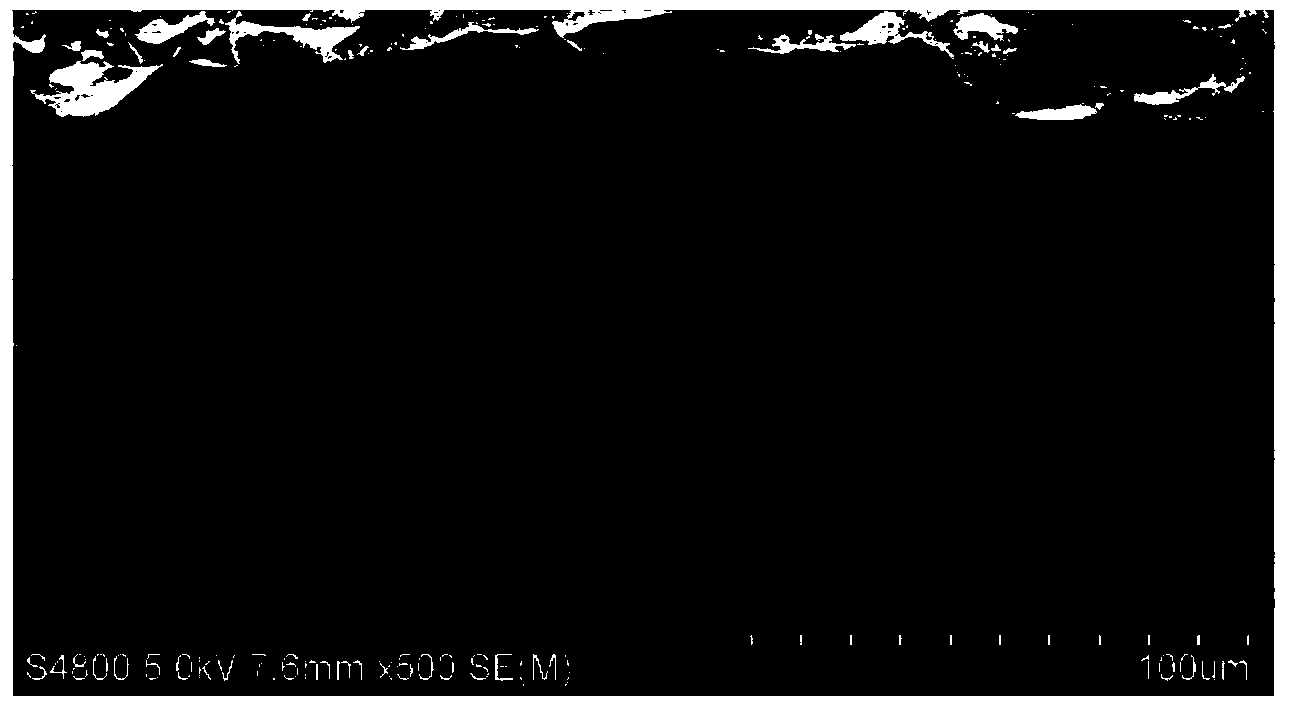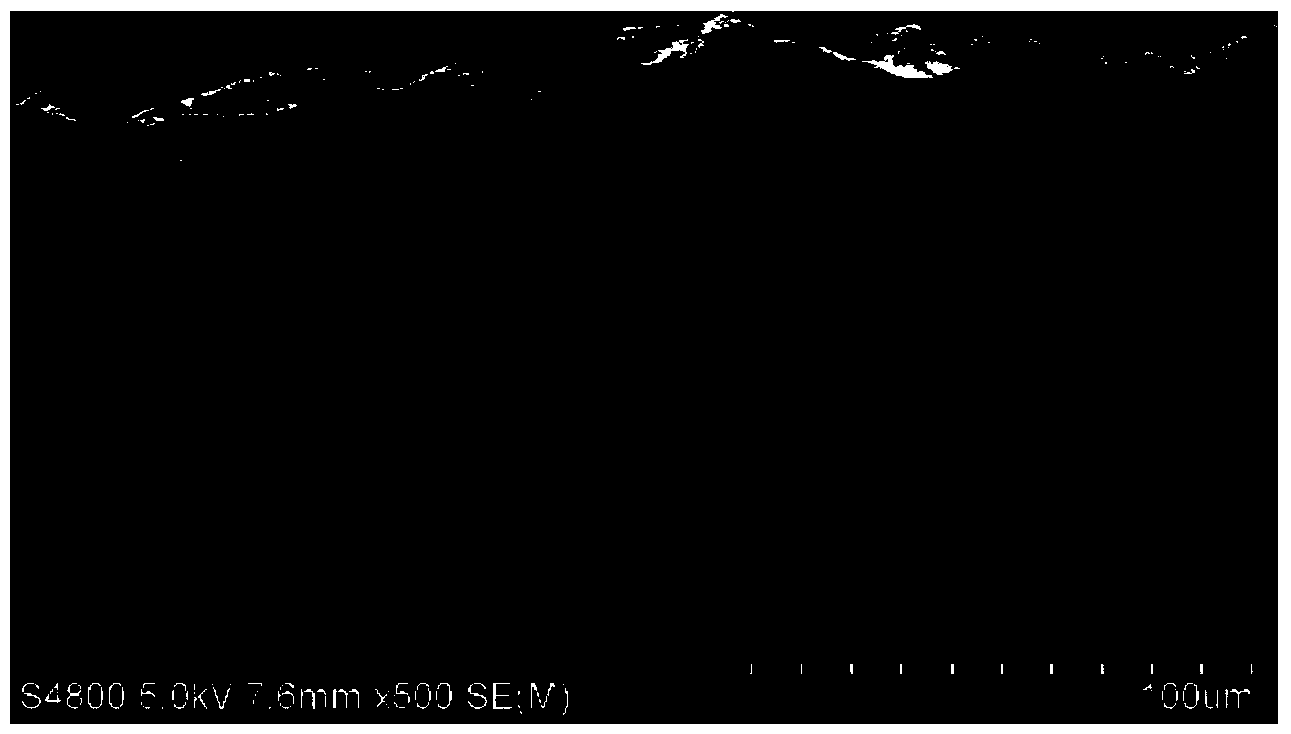Novel method for preparing organic-solvent-resisting polyimide nanofiltration membrane through inorganic salt pore-forming agent
A technology of polyimide and inorganic salt is applied in the field of preparation of polyimide nanofiltration membrane, which can solve the problems of increasing solvent resistance and limited solvent resistance.
- Summary
- Abstract
- Description
- Claims
- Application Information
AI Technical Summary
Problems solved by technology
Method used
Image
Examples
Embodiment 1
[0022] Add 0.5gZrCl 4 Add to a mixed solution of 50ml of solvent N-methylpyrrolidone, 44ml of tetrahydrofuran, 1.5g of PEG200, and 4g of maleic acid, and ultrasonically disperse at room temperature for 10 minutes to obtain a uniformly dispersed solution. 20.5g of polyimide was added to the above solution, electromagnetically stirred for 20h, filtered, degassed, and stood still. Coat the casting liquid uniformly on the polyester non-woven fabric under the conditions of 30℃ and 40% relative humidity, volatilize for 40 seconds, immerse the wet film in an ethanol coagulation bath containing 4wt% hexamethylene diamine for 10 minutes, and then deionize Washed in water 3 times, after soaking in isopropanol for 24h, immersing in n-hexane for 24h, and methyl ethyl ketone / toluene / lubricating oil (mass ratio 2:2:1) for 24h, then put it in the air to dry to obtain the required resistance Solvent nanofiltration membrane. The membrane has a retention rate of 97% for ketone-benzene lubricant...
Embodiment 2
[0024] 1gZrCl 4 Add to a mixed solution of 47ml of solvent N-methylpyrrolidone, 45ml of tetrahydrofuran, 2g of PEG200, and 5g of maleic acid, and ultrasonically disperse at room temperature for 10 minutes to obtain a uniformly dispersed solution. Add 22 g of polyimide to the above solution, ultrasonically disperse for 30 min, filter, degas, and stand still. Coat the casting liquid uniformly on the polyester non-woven fabric under the conditions of 30℃ and 50% relative humidity, volatilize for 50 seconds, immerse the wet film in an ethanol coagulation bath containing 6wt% hexamethylene diamine for 10 minutes, and then deionize Washed in water 3 times, after soaking in isopropanol for 24h, immersing in n-hexane for 24h, and methyl ethyl ketone / toluene / lubricating oil (mass ratio 2:2:1) for 24h, then put it in the air to dry to obtain the required resistance Solvent nanofiltration membrane. The membrane has a retention rate of 95% for ketone-benzene lubricants and a flux of 40.5L...
Embodiment 3
[0026] 1gZrCl 4 Add to the mixed solution of 50ml solvent N-methylpyrrolidone, 44ml tetrahydrofuran, 1gPEG200, 4g maleic acid, and electromagnetically stir for 0.5h at room temperature to obtain a uniformly dispersed solution. 20.5g of polyimide was added to the above solution, electromagnetically stirred for 20h, filtered, degassed, and stood still. Coat the casting liquid uniformly on the polyester non-woven fabric under the conditions of 32℃ and 40% relative humidity, volatilize for 50 seconds, immerse the wet film in an ethanol coagulation bath containing 8wt% APTMDS for 30 minutes, and then use deionized water After cleaning 3 times, after soaking in isopropanol for 24 hours, immersing in n-hexane for 24 hours, and methyl ethyl ketone / toluene / lubricating oil (mass ratio 2:2:1) for 24 hours, then dry in the air to obtain the required solvent resistance Nanofiltration. The rejection rate of the membrane to ketone-benzene lubrication is 99%, and the flux is 44L·m -2 ·H -1 An...
PUM
 Login to View More
Login to View More Abstract
Description
Claims
Application Information
 Login to View More
Login to View More - R&D
- Intellectual Property
- Life Sciences
- Materials
- Tech Scout
- Unparalleled Data Quality
- Higher Quality Content
- 60% Fewer Hallucinations
Browse by: Latest US Patents, China's latest patents, Technical Efficacy Thesaurus, Application Domain, Technology Topic, Popular Technical Reports.
© 2025 PatSnap. All rights reserved.Legal|Privacy policy|Modern Slavery Act Transparency Statement|Sitemap|About US| Contact US: help@patsnap.com


